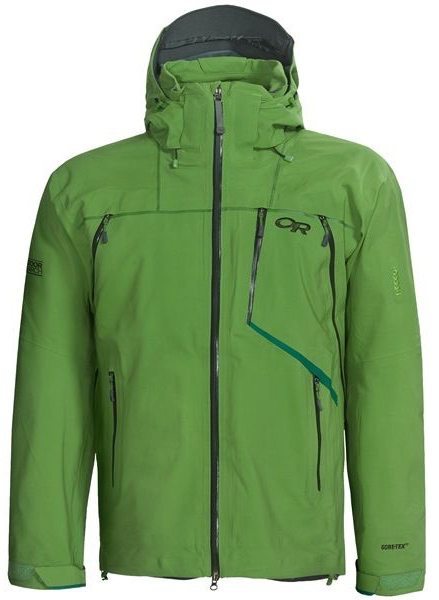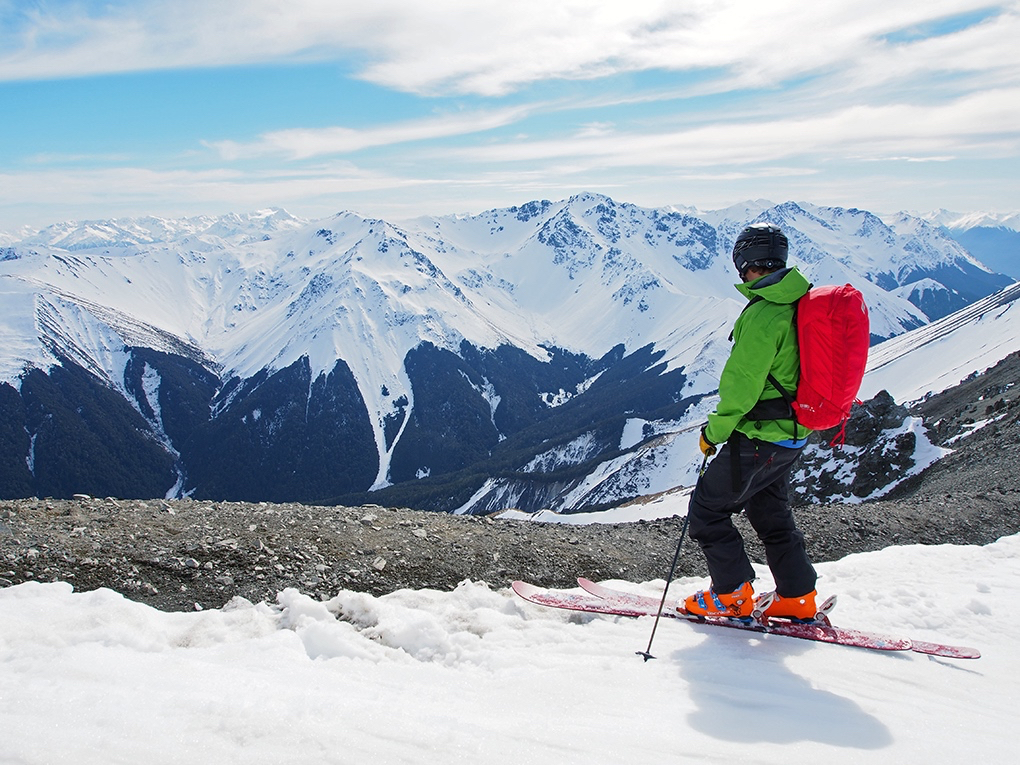 Outdoor Research Vanguard Jacket
Outdoor Research Vanguard Jacket
Size Tested: Large
Reviewer Stats: 6’, 190 lbs
Color Tested: Leaf
Stated Weight: 35.7 oz
Material: Gore-Tex Soft Shell
Features:
- Waterproof, Windproof, Breathable
- Movement-Mirroring Stretch
- Fully Seam Taped
- Water-Resistant Zippers
- Fully Adjustable and Detachable Hood
- Adjustable Wire Brimmed Hood
- Bonded-In-Hood Cordlocks
- Internal Front-Zip Stormflap
- Double-Sliding CrossFlo Chest-to-Hip Zippers
- Zippered Napoleon Pocket with Media Port
- Internal Shove-It Pockets
- Two Zippered Hand Pockets
- Inner Lift Pass Pocket
- Integrated RECCO Reflector
- Removable Powder Skirt with LockDown Technology
- Articulated Elbows
- Drawcord Hem
MSRP: $595
Days Worn: 15
Locations Tested: Broken River Ski Area; Craigieburn Valley Ski Area; Temple Basin Ski Area; Mt. Cheeseman Ski Area; Kodiak, Chugach Mountains, and Alyeska Resort, Alaska
Intro
[Editor’s Note: This review is of the 13/14 Vanguard jacket, which was unchanged for the 14/15 season, except for the colors offered.]
Outdoor Research describes the Vanguard as a jacket “designed for the skier who needs ultimate protection across the widest range of climates, the Gore-Tex soft shell fabric of the Vanguard Jacket provides warmth and ultimate protection against wind, deep snow and wet storms.” Since I spend a lot of my time touring and some time in the resort in the wet climate of Alaska, the idea of a more versatile, more weather-proof soft shell sounded quite appealing.
Fit
The size Large Vanguard fits my 6’, 190 lb frame well; I typically wear a Large, and found the jacket to fit true to size. The length is also adequate, covering about half of my butt, which is similar to the length of the Arcteryx Rush Jacket. The sleeves are long enough for me, and provide good coverage when wearing shorter gauntlet gloves.
The Vanguard has enough room for multiple layers underneath. Since the jacket is quite warm (which I’ll touch on in a bit), I probably would never need to wear more than a light puffy with the Vanguard, though it is still roomy enough to pair with a mid-weight puffy.
Fabric
One of the most distinguishing features of the Vanguard jacket is the use of Gore-Tex’s Soft Shell fabric, which features the same waterproof / breathable membrane found in Gore-Tex Performance Shell fabric, paired with a soft, thin, fleece backing. This gives the fabric a softer but somewhat heavy, weighted feel.
Though the technical distinction between a soft shells and hard shells is blurring these days with the advent of air permeable waterproof membranes, it could be said that Gore-Tex Soft Shell is not a “true soft shell” in that its laminate construction includes a waterproof / breathable membrane. Many soft shell fabrics (like Polartec Power Shield Pro) lack a truly waterproof membrane, and sacrifice some of their waterproofing and windproofing capabilities for increased breathability. As I’ll discuss below, the difference in breathability between the Vanguard, with Gore-Tex Soft Shell, and other soft shell garments is apparent.

Gore-Tex Soft Shell is designed to make a garment that is warm and soft to the touch that, in theory, allows for less layering while still providing enough warmth and water / wind protection.
One downside of the Gore-Tex Soft Shell fabric is that it makes for a bulkier and heavier jacket or pair of pants. Ideally this could be offset by the fact that you can leave behind an extra layer, but I’ve found that one heavier fleece-lined jacket can’t compete with the performance and layering options provided by a light fleece shirt and a light shell jacket.
Waterproofing
Quite uncharacteristic of New Zealand, we did not encounter any significant precipitation during our trip. Since I’ve been home in Alaska, I’ve worn the Vanguard skiing on wet days at Alyeska, as well as hiking around in the rain looking for surf on Kodiak Island. In such rainy conditions, the Vanguard performs similarly to other Gore-Tex pieces I’ve used in that water does not penetrate through the fabric.
So far, the jacket’s zippers are holding up well to water, and I have not had the “wet necktie” experience that I sometimes encounter when zippers fail while skiing in the rain and wet snow. The fleece lining feels soft and warm against my bare arms on cold & rainy days compared to thinner 3-ply fabrics that can feel a little clammy and cold. However, when that fleece lining gets wet from sweat or stuffing in and out of packs, it stays wet a lot longer than the thinner, less absorbent backing material found in Gore-Tex’s Active, Performance, and Pro shells fabrics.
Breathability
While I tend to run pretty warm when I’m out in the mountains, the Vanguard is the warmest but least breathable shell I’ve used. It’s possible that I’m occasionally overdressing, underestimating the extra warmth provided the fleece lining, but I definitely haven’t found the Vanguard to breathe as well as jackets that use Gore-Tex Pro or Active Shell hard shell fabrics, despite its soft shell designation.
In general, I feel a bit more hot and wet in the Vanguard than I do in other shells, and I find myself using the vents far more often. In New Zealand, we encountered fairly mild temperatures; it never dropped below 25ºF, but got as warm as the mid 40s on other days. I spent most of my days wearing only a Patagonia Merino 1 t-shirt under the Vanguard, and was still pretty warm. In those conditions, pairing a jacket with more breathable Gore-Tex Active, Pro shell, or Polartec NeoShell fabric and a light fleece shirt would have been more comfortable through a wider range of temperatures.
While the Vanguard’s fabric is not the most breathable, the jacket’s huge, well-placed pit zips do provide really good airflow. Unlike most jackets that have pit-zips running more or less along the underarm’s seam, the vents on the Vanguard start around the mid-clavicle region and wrap around toward the outside of the hip.
With the vents open, air rushes directly into the body of the jacket while I’m moving. I have used a lot of different jackets with various pit zip and ventilation configurations, but none of them dump heat and pull in cold air while skiing as well as the Vanguard. On wet days, opening the top vents would typically soak the user while skiing downhill, but the double set of 2-way zippers enables you to open the vents down by the hips and prevent too much water from getting in. Overall, the Vanguard’s ventilation system is excellent, which I found to be necessary given the warm, but not so breathable fleece backer.
Pockets
The pocket layout on the Vanguard is relatively conventional. There are two decent-sized hand pockets that are big enough to stash a hat or gloves while hiking. The chest pocket has an electronics port and a separate zippered compartment that can fit a phone or small wallet. There is a small zippered pocket on the inside of the jacket that I did not did not really use, but I like the addition of a pass holder on the sleeve.

A feature that I’ve come to appreciate in a ski jacket is the addition of inner mesh pockets to hold skins on backcountry descents, since it is important to keep skins warm and close to the body when making a lot of laps in colder weather. Even without such pockets, I will still tuck my skins into the body of my jacket; however, large mesh pockets are much more secure, add little weight, and are also handy for stashing gloves, goggles, or water bottles. The inner mesh pockets on the Vanguard can fit skins, but just barely and it’s a super tight fit, which doesn’t make the pockets practical or easy to use when on the move in the mountains.
Hood
It seems like hoods are one of the tougher features to get right on a technical jacket, and I encountered some issues with the Vanguard’s hood. First, the hood is removable, which is a feature I have not had on a shell jacket before. Aside from my experience with the Vanguard, I personally can’t think of the last time I felt like the hood on one of my shell jackets was such an inconvenience or liability that I would want to remove it; but, I imagine that some folks who spend most of their time in the resort with more predictable, sunny conditions might find that to be a nice feature. The downside of a removable hood is that it creates more bulk and weight with extra zippers and snaps. Since we had virtually no precipitation in New Zealand, and I found the Vanguard’s hood to be more cumbersome and floppy than any other I’ve worn on a shell, and I did end up removing it.
The shape and size of the hood also has room for improvement. Even though the hood can be adjusted, it still felt tight when worn over a helmet and loose and insecure when worn with a beanie or ball cap hat. In contrast, the Arc’teryx Rush jacket has the best hood I’ve used in a long time; it can easily expand to fit over my helmet without being restrictive and can also compress down for a comfortable, secure fit over a light hat.
Powder Skirt
Although I haven’t had the opportunity to wear the Vanguard in deep powder yet, or wear it in conjunction with OR pants that interface with the powder skirt system, the powder skirt seems to work quite well. It’s just a little bukier than powder skirts I’ve used on other jackets.
Durability
While I will need to update this section once I have more time in the Vanguard, it has held up well so far with few signs of wear. Even though I usually prefer plastic molded zippers, the covered, coil zippers on the Vanguard are thick and appear to be well constructed.
Bottom Line
The Outdoor Research Vanguard is a well-constructed shell that has qualities of both a soft shell and a hard shell. Despite its excellent ventilation system, the jacket’s weight, bulk, unimpressive hood, and decreased breathability make me less inclined to use it for ski touring or any high-output activity. However, for those who spend most of their time in the resort and are looking for a storm-proof jacket with a soft, comfortable feel and removable hood, the Vanguard could be a great choice.
